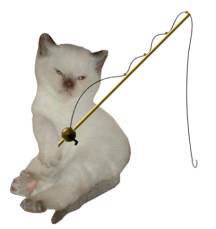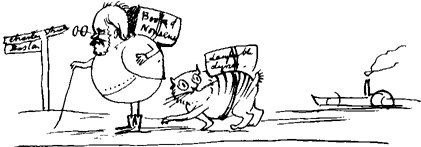

|
FAMOUS CATS |
|
Sugar In 1951 Mr and Mrs Woods moved to Oklahoma, leaving their cat, sugar behind with neighbours because he hated travelling in cars. After two weeks living with the neighbours the cat vanished, never to be seen again. Fourteen months later he jumped through a window and onto the shoulder of Mrs Woods. Amazed that the cat could have travelled so far (1,500 miles) he was given a very close examination, as Sugar was a part-Persian with a deformed hip. But it was unmistakably him! How he had managed to navigate his way over such a distance remains a mystery. |
|
Kaspar the "Lucky" Wooden Cat The Savoy Hotel in London has a wooden cat that sits at the table with a napkin tied around its neck, and the waiters are always careful to change the place-settings for each course of the meal. Kaspar the "lucky" wooden cat always occupies the fourteenth seat when dinner parties number thirteen. A tradition which remains to this day. The superstition must have some significance, as a gentleman who had been forced to host a party of thirteen, because one of his guests had cancelled at the last moment, was later found shot dead in his office. After this incident, the Hotel always provided a staff member if a party had thirteen guests. However, as some of the conversations were often of a confidential nature, wooden-eared Kaspar was conceived to become a convenient fourteenth guest. The black wooden cat, carved by Basil Ionides in 1926, has been used by many famous guests over the years including, on many occasions, cat-lover Sir Winston Churchill. |
|
Foss Foss was owned by artist and humorist Edward Lear. The kitten was introduced to the Lear household in 1873, when a misguided servant cut the poor kitten's tail off because he thought this would stop it from straying. The unfortunate tom-cat was not at all handsome, nonetheless, he became famous through the cartoons drawn by his master. Mr. Lear loved the cat so much that when he moved to a new area, he instructed the architects to design his home as an exact replica of his previous one. This was solely to make the transition to the new home as less stressful as possible for his feline friend.
Foss died in 1887, and was given a full burial with a large tombstone in Mr Lear's Italian garden. Why the age of Foss is recorded on the tombstone as 31 years instead of reading 14 years remains a mystery. But it was only two months later when he himself died at the age of 76.
|
|
PRESIDENTIAL CATS |
|
|
CATS & WAR |
|
Persians and Egyptians at War 2,500 years ago the Persians, knowing the Egyptians considered cats to be sacred took live cats to the front line of battle. The Egyptian soldiers would not attack in case they accidentally killed one of these animals. Christopher of Hapsburg's Book Recorded in the artillery officer, Christopher Of Hapsburg's book in 1535 is a report to the Council of One and Twenty at Strasbourg in which he describes cats being used to spread poison vapours by strapping bottles of poison to their backs, with the openings pointing towards their tails. They were sent running in total panic, towards the enemy. World War l. 500 cats were sent to the front line trenches to be used as poison gas "detectors" acting as early warning systems. It is not known if any cats survived to return to England. World War ll. A cat named Mourka was used to carry messages across a street during the siege of Starlingrad in 1942. Mourka became a hero, and the Times of London in a leading article ended with the words: "he has shown himself worthy of Stalingrad, and whether for cat or man there can be no higher praise". "Bomber" During the blitz in England a cat nicknamed "Bomber" could tell the difference between the sounds of RAF and German aircraft at distance, and thus became a good early warning system for its human companions. There are several instances were cats have saved the lives of whole families. Seeing their cats dashing to shelters, people would follow, getting to safety just before the bombs started to fall. Cats at Sea There was a very famous cat named Oscar who saw service with the German and the British Navy. He started out as a mascot on the German battleship Bismarck. When this ship was sunk in 1941 he was seen swimming among the wreckage by a British sailor who took him on board the destroyer, HMS Cossack. Five months later the Cossack was sunk, Oscar survived and was transferred to the aircraft-carrier Ark Royal. Ark Royal was torpedoed by a U-boat, and Oscar was rescued yet again! This time it was decided to retire him to a sailors home, where he lived out his much less stressful life. |












